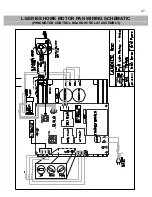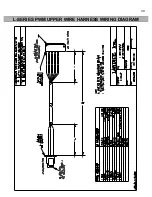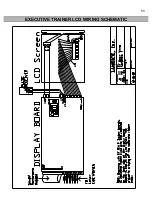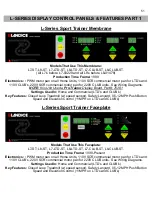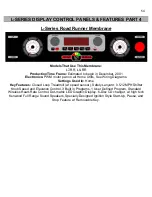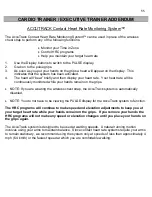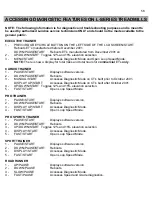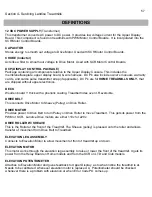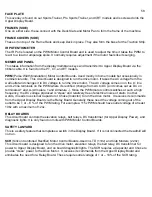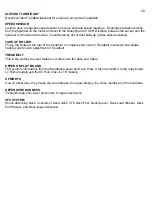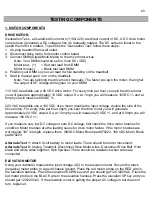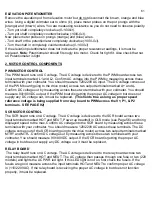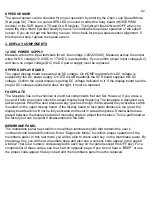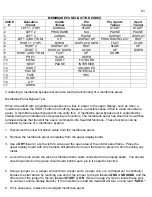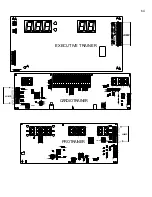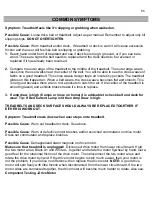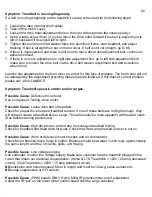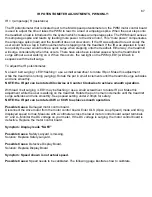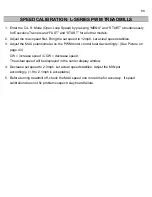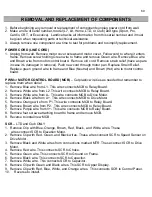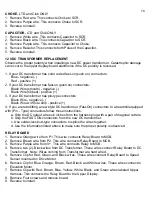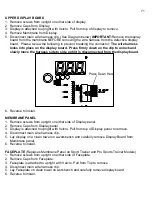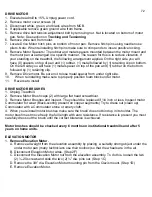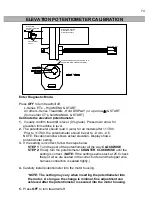
61
ELEVATION POTENTIOMETER
Remove the elevation pot from elevation motor but do not disconnect the brown, orange and blue
wires. Using a digital voltmeter set to ohms (
Ω
), place meter probes on the pot prongs with the
(
orange) and (brown) wires. You are measuring resistance so you do not need to observe polarity.
-
Turn pot shaft completely clockwise (0-1000
Ω
).
-
Turn pot shaft completely counterclockwise (1000-0
Ω
).
Now place meter probes on prongs (orange) and (blue) wires.
-
Turn shaft of the potentiometer completely clockwise (1000-0
Ω
).
-
Turn the shaft in completely counterclockwise (0-1000
Ω
)
If the elevation potentiometer does not indicate the proper resistance readings, it is must be
replaced.
Note
: Potentiometer should fit snugly into motor. Check for tight fit. Also check that nut
on Potentiometer is tight.
2. MOTOR CONTROL COMPONENTS
PWM MOTOR CONTROL
The PWM board runs on AC voltage. The AC voltage is delivered to the PWM board across two
input terminals marked L1 and L2. Confirm AC voltage into the PWM by measuring across these
terminals with your voltmeter. You should measure 120/220VAC input. The DC voltage comes out
of the PWM board (going to the drive motor) across two output terminals marked A+ and A-.
Confirm DC voltage out by measuring across these two terminals with your voltmeter. You should
measure 90/180VDC output. If the PWM board is getting the proper AC voltage in but does not
supply any DC voltage out, it must be replaced.
(This holds true as long as proper speed
reference voltage is being supplied from relay board to PWM across the V+, P1, & P2
terminals. SEE PAGE 92)
SCR MOTOR CONTROL
The SCR board runs on AC voltage. The AC voltage is delivered to the SCR board across two
input terminals marked HOT and NEUT. Power up treadmill in OLS mode (see Page 56) and bring
displayed speed to the max. Confirm AC voltage into the SCR board by measuring across these
terminals with your voltmeter. You should measure 120/220VAC across these terminals. The DC
voltage comes out of the SCR board (going to the drive motor) across two output terminals marked
MTR+ and MTR-. Confirm DC voltage out by measuring across these two terminals with your
voltmeter. You should measure 90/180VDC output. If the SCR board is getting the proper AC
voltage in but does not supply any DC voltage out, it must be replaced.
RELAY BOARD
The relay board runs on AC voltage. The AC voltage is delivered to the relay board across two
input terminals marked HOT and NEUT. The AC voltage then passes through one fuse or two (220
models) and lights the AC PWR led light. If this LED light is not on, first check the fuse/s. If the
fuse/s are good measure across the input terminals HOT and NEUT to confirm proper AC voltage
in (110/220VAC). If the relay board is receiving the proper AC voltage in but does not function
properly, it must be replaced.
Summary of Contents for Cardio Trainer L8
Page 5: ...5 ...
Page 27: ...27 Section 3 Parts Identification L8 L9 BED EXPLODED VIEW 18 ...
Page 28: ...28 L7 BED EXPLODED VIEW L Series Upright ...
Page 29: ...29 L SERIES UPRIGHT EXPLODED VIEW 112 ...
Page 30: ...30 L SERIES MOTOR PAN EXPLODED VIEW 111 ...
Page 35: ...35 COMMERCIAL MOTOR PAN SCR MOTOR CONTROL BOARD ...
Page 36: ...36 L SERIES 110V COMMERCIAL LOWER WIRE SCHEMATIC ...
Page 37: ...37 L SERIES 220V COMMERCIAL LOWER WIRE SCHEMATIC ...
Page 40: ...40 L SERIES SCR UPPER WIRE HARNESS WIRING DIAGRAM ...
Page 42: ...42 L SERIES HOME MOTOR PAN WIRING SCHEMATIC ...
Page 47: ...47 L SERIES HOME MOTOR PAN WIRING SCHEMATIC PWM MOTOR CONTROL BOARD W RELAY ASSEMBLY ...
Page 48: ...48 PWM MOTOR CONTROL BOARD W RELAY ASSEMBLY ...
Page 49: ...49 L SERIES PWM UPPER WIRE HARNESS WIRING DIAGRAM ...
Page 50: ...50 EXECUTIVE TRAINER LCD WIRING SCHEMATIC ...
Page 110: ...110 L SERIES ROAD RUNNER LOWER WIRING DIAGRAM ...
Page 111: ...111 L SERIES ROAD RUNNER UPPER WIRING SCHEMATIC ...

